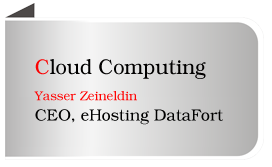

What solutions is your company offering in the cloud space?
eHDF launched Cloud Services at GITEX Technology Week 2012. With a long pedigree of providing managed hosting services in the region, it has been a natural evolution for eHDF to launch cloud services. Among the first service providers in the region to launch these services, eHDF has already gained consistent interest and momentum amongst its clientele in the UAE. We have acquired a number of customers for our virtual data centre private cloud offering, beating local and international competition.
eHDF is delivering a range of different cloud solutions, both public and private, managed and unmanaged.
eHDF's Managed Private Cloud Solutions are targeted at medium to large enterprises looking at enhanced and dynamic utilization of existing infrastructure/ applications in terms of scalability, elasticity and faster time to market. In addition to facilitating shared resources and reduced investments on hardware, the services will allow companies to buy capacity-based options rather than making purchases based on set specifications - a key imperative for growing businesses as they move online and require rapid provisioning.
eHDF is also offering SMBs cost-effective and customized Public cloud services.
Do you have any customers using these solutions at present?
eHDF is responsible for implementing the first private cloud in the UAE to EMCOR Facilities Services (EFS), an integrated facilities management service, operation and maintenance solution provider in the MENASA (Middle East, North Africa, and South Asia) region.
Following EFS' in-depth analysis of working with an external managed hosting service provider as opposed to investing in an in-house data centre, the company subsequently made an informed decision to migrate the systems to a hybrid model. By this, EFS invested in high-end computing hardware and security, including servers and firewalls, while the data centre infrastructure, core switching, perimeter security, load balancers and storage area networks were leased from eHDF.
At present eHDF is hosting EFS' main business application suite, the Oracle JD EnterpriseOne, which being a Tier-1 application required a competent technology delivery platform.
eHosting DataFort was selected for its expertise in providing fully managed services, and because it is the only managed service provider with three production and disaster recovery data centres in Dubai.
What barriers still exist to cloud uptake, and can they be overcome?
- Typical apprehensions that exist for managed services apply in the case of Cloud also. However, the mindset is changing. The mindset of having the servers in-house is changing and organisations are now realising the value of working with external service providers. Companies are looking at the private cloud which can be implemented in their own premises or at a service provider data centre.
- There is a lack of a clear understanding of the cloud and differentiation between cloud and virtualization. There exists also a lack of awareness amongst enterprises with regards to availability of local providers offering such services.
- There is still more focus towards infrastructure rather than application.
- Most businesses often cite security as a key inhibitor to the adoption of cloud computing. This can be addressed by implementing proper security controls and mechanisms.
- Organisations such as the government and financial sector organisations are wary about sharing confidential information in the cloud and want to stay in full control of their data as they have various regulatory requirements. They prefer having their data in-house or at a third party data centre located within the same country where they have easy accessibility to their data.
Do customers understand the value of cloud?
A comprehensive understanding of exactly what 'the cloud' is, and its value to end users is still a grey area. This is partly due to no clear definition, which has led to varying interpretations. Ultimately cloud computing offers a way to increase capacity or add capabilities without investing in new infrastructure, training new personnel, or licensing new software.
We are encouraging and witnessing many of our partners and clients offering training and education as part of their service offering. As education becomes more prevalent and understanding of cloud computing increases, the value add of the concept will gain traction and ultimately eHDF will benefit from this development.
Are you developing specific cloud solutions for the region?
Our solutions are completely customized and provide clients with the flexibility to buy private or public cloud platforms and leverage appropriate options.
What new cloud solutions are you planning in future?
We are looking at launching Virtual Desktop Infrastructure (VDI) and Cloud Storage in the future.
What considerations does a customer needs to take into account before adopting cloud computing?
It's all about managing resources in the right manner. Therefore, cloud may not be the solution applicable to everyone. There are a number of factors to be considered, eg. nature of the organisation and application workloads, time to market, stable IT infrastructure and time of deployment required by the organisation. Many a times, you don't need cloud for all applications as cloud is good for certain scenarios which provide more value to businesses.
In terms of workloads, we see higher adoption towards low/non critical workloads such as e-mail, Storage, CRM, etc. which have a greater uptake in terms of Cloud Computing applications used by enterprises.
There is no one size fits all strategy when it comes to the cloud. It is completely based on the number of business users existing in the organisation as well as whether the organisation is an SMB or large enterprise, and the choice between private, public or hybrid cloud would depend on the organisation's overall IT strategy.
New businesses, for example, may choose to use all their applications in the cloud. If they are starting from scratch, they will want to be up and running as quickly as they can. More established organisations might choose to virtualise in stages, gradually moving to cloud computing via managed hosting and infrastructure sharing as their on-premise hardware approaches end of life.
